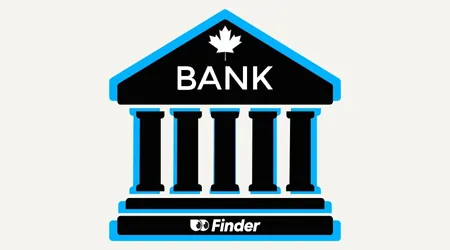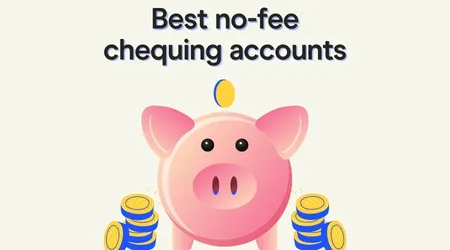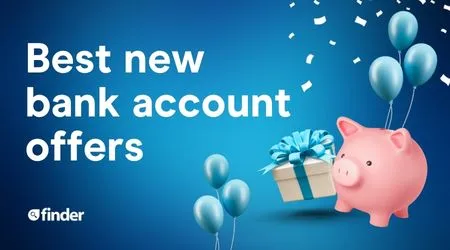Compare chequing accounts
Finder Score for chequing accounts
To make comparing even easier we came up with the Finder Score. Welcome offers, account fees and features across 60+ chequing accounts and 25+ lenders are all weighted and scaled to produce a score out of 10. The higher the score the better the account - simple.
A good chequing account makes it easy to manage your money. But how do you know which account is right for you? Let’s break down the different types of chequing accounts in Canada, including features, how chequing and savings accounts differ and how to open and close a chequing account in Canada.
What is a chequing account?
Also known as an everyday banking account or a spending account, a chequing account lets you manage your money with little or no limits. You can deposit your paycheque directly into your chequing account and access your money via ATMs, electronic transfers, cheques, email money transfers and (depending on the financial institution) cash back on debit purchases.
In simpler terms, it’s an account with features to help you pay bills, go grocery shopping and withdraw cash from an ATM. The best Canadian chequing accounts will help you manage your everyday finances efficiently and help you reach your financial goals.
What are the typical features of a chequing account?
- Not good for earning interest. Your chequing account holds funds that are accessible on demand, so banks don’t pay interest as there isn’t an incentive for holding your funds. If you’re looking for a high interest rate, a savings account may be more suitable.
- Linked debit card. A debit card is a spending card that’s linked to your chequing account so you can access your money at ATM’s, debit card terminals and online. Many debit cards have security chips that let you use Mastercard Tap & Go or Visa payWave to make purchases in a few seconds by holding your card up to the debit terminal. Alternatively, you can punch in your PIN to access your funds.
- Free in-network ATM access. Your debit card lets you access your funds from an Automatic Teller Machine (ATM). Your bank will also provide you with a network of ATMs that you can use for free. Some banks may also have global ATM alliances, which means you can freely access your money using specific ATM’s overseas.
- International ATM access (for a fee). If your bank doesn’t have a global ATM alliance, you’ll incur a fee when withdrawing funds from an overseas ATM.
- Link to your savings account. Many financial institutions let you link your chequing and savings accounts so you can easily transfer money back and forth and make the most of the higher savings account interest rates.
What are the different types of chequing accounts?
![]()
- Basic personal chequing account. This is the most common type of chequing account in Canada, which usually comes with a set number of monthly transactions and a monthly fee, among other features.
- No-fee chequing account. It’s possible to find a chequing account with no monthly fees as well as unlimited free transactions and Interac e-Transfers, but these are often offered by online banks that may not offer a full suite of financial products and services.
- Interest earning chequing account. Most chequing accounts don’t pay interest in your balance, but some do, but the rate will probably be much lower than a high interest savings account.
- Cash back chequing account. Another uncommon type of account, a cash back chequing account can help you earn back some of what you lose on bank fees and expenses by rewarding you with cash back for your spending.
- Student account. These chequing accounts are designed for students or youth under 18 who are looking for low-cost everyday banking solutions. You’ll usually need to meet eligibility criteria like age and education requirements.
- US dollar chequing account. If you shop or travel in the US frequently, a US chequing account can help you save a lot on fees and conversion rates. These can usually be linked to CAD bank accounts, giving you easy access to funds no matter where you are. Learn more about cross-border banking.
Chequing vs savings account: What’s the difference?
The typical account holder should have a chequing account for everyday use and a savings account to hold their savings. Here are the key savings vs chequing account differences.
| Chequing account | Savings account | |
|---|---|---|
Purpose | Everyday spending | Saving or accumulating wealth |
Features |
|
|
Drawbacks |
|
|
The benefits of having a chequing account
- A convenient way to organize your money. Pay your bills, receiving your salary or benefits, pay for goods and services or send money to someone else.
- A safe place to keep your money. This is especially helpful during uncertain economic climates. Your chequing account is “on demand,” meaning you can access your funds at any time.
- A place that records your transactions. When applying for a loan, lenders will be able to refer to your transaction records to assess how well you can save money. You can also see where you’re spending most of your income.
- A place to build your assets. Money held in your chequing account is easy to access—by linking it to a savings account, you can also earn interest.
- If you’re unhappy, you can easily change accounts or banks. One of the great things about bank accounts are that they can be a short term commitment. So if you’re unhappy with your current bank account, you can always switch to a new bank. Review your needs regularly to see if your chequing account still meets them.
What are the risks of having a chequing account?
- Choosing the wrong type of account. Each type of account serves a very specific purpose. Not choosing the right one could result in paying unnecessary fees or penalties.
- Not having the right features. Look closely at your account to ensure it has the features you need to make your banking needs easier.
Questions to ask when choosing a chequing account
![]()
Here are some questions to ask to help you find the right chequing account for your needs:
- What’s your standout feature? This is the one feature or characteristic that your chequing account must have. Some people prefer convenience and flexibility, while others want unlimited monthly transactions or no fees.
- Are the features worth the fees? Most chequing accounts come with a monthly fee. But as the banking industry gets more competitive, more options for avoiding fees are arising. The rise of internet banking has almost made teller fees a thing of the past, and some banks waive the monthly fee if you set up direct deposit or bundle your chequing account with other financial products.
- What type of bank account do I need? Chequing accounts are designed for everyday banking—whether it’s depositing your paycheque, paying for bills and buying groceries. Compare a range of chequing accounts including basic, no-fee, interest-bearing, US dollar, student accounts and more to find one that’s right for you.
Can I open a fully online chequing account?
Yes, some banks operate entirely online, and many major banks and credit unions offer chequing accounts you can open and maintain without needing to visit a branch in person. An online chequing account is an everyday banking account that comes with a debit card to pay for purchases and access cash. You can manage your funds online or via mobile app.
If you’re thinking of going digital, compare online bank accounts based on:
- Customer service. If you can’t visit a branch for help, check which methods are available for getting a hold of customer service. Is help available 24/7, or only during certain hours? Can you use live chat to get answers?
- Fees. This includes monthly maintenance, ATM, foreign transaction and overdraft fees.
- Account access. What functions are available in the bank’s app or online? Can you easily transfer money to another account? Can you deposit cheques via mobile app?
- ATM network. How large is the bank’s ATM network? Can you easily access cash when you need it?
Quick tips making the most of your chequing account
- When shopping at stores that support cash back transactions, ask for cash at the time of purchase instead of withdrawing it from an ATM. This counts as one transaction, not two, and lets you avoid potential fees.
- If your chequing account comes with a limited number of free monthly transactions, keep an eye on your spending history and try to minimize transactions where possible.
- If you’re currently paying a monthly chequing account fee, ask your bank if there are any ways to get the fee waived. They may suggest opening a savings account, depositing your salary into your chequing account or maintaining a minimum daily balance. Or, they may suggest a different chequing account that better suits your needs.
How do I open a chequing account?
Once you’ve chosen the right Canadian chequing account, navigate to the bank’s website where you can start your secure online application. Depending on your personal situation, you may need to consider the following when opening a chequing account:
Eligibility requirements
- Age. Unless you have a parent or guardian co-applying for the account, you’ll need to be at least the age of majority in your province or territory.
- Residency. You’ll likely need to be a Canadian citizen or permanent resident with a valid Canadian address. If you’re a temporary resident, you’ll need a valid passport and immigration papers to apply.
Required documents
- Personal details. You’ll need your personal details on hand, including your full name, address, phone number and email address.
- SIN number. Banks will ask for your Social Insurance Number to verify your identity and other details on your application.
- Two valid pieces of ID. Provide two pieces of valid government-issued ID, such as a passport and a driver’s licence. Utility bills, credit card statements, rental agreements or other documents showing your name and address may be acceptable for one of those pieces of ID.
What happens after I’ve submitted my chequing account application?
Depending on the bank, your account could be opened immediately or within a few business days. Your bank will send you a package confirming the details of your new chequing account along with your new debit card. You’ll need to activate your debit card. The instructions for doing so will be included in the welcome package.
Using PayPal with a chequing account
How to close a chequing account
If you want to close your chequing account, make sure all your direct debits and credits have been successfully cancelled or transferred to a different account and you’ve given any new chequing account details to anyone who pays you money or withdraws payments from your account.
You may be able to close your chequing account online, but it may be easier to go to a branch. Some major banks and credit unions may even require this. Closing your account over the phone may also be an option.
If you want to be absolutely sure that your account is closed, try logging into your account online to see if it’s still active. You can also call or go into a local branch and ask a teller to verify that you’re no longer in their system.
If you’re no longer using a chequing account, it’s important to close it, as your bank may charge inactivity fees or monthly maintenance fees may continue being charged.
Chequing account FAQs
A-Z list of chequing account reviews
From CDIC-insured institutions to trendy apps and digital banks, find a chequing account product that fits your needs. Click on a bank name to compare chequing account offerings and rates.
More banking guides from our experts

Banking statistics and trends in Canada for 2025
Explore key banking statistics and figures from the Finder: Consumer Sentiment Survey January 2025.
Read more…
Best free (no-fee) chequing accounts in Canada
Compare the features of 8 of the best no-fee chequing accounts in Canada, and find out how to avoid transaction fees.
Read more…
16 best new bank account offers for May 2025
Earn cash, rewards points, bonus interest rates and more with these new bank account offers and promotions.
Read more…
Best youth bank accounts in Canada
Learn about the different types of bank accounts for your teenager and how to choose the right one.
Read more…
Best chequing account in Canada for 2025
Compare chequing accounts and learn about our top picks. Compare different features and see which one is right for you.
Read more…
Open a bank account online in Canada in 5 easy steps
Compare and open a bank account online in Canada in as little as 5 minutes. Learn what you need to apply and how to get started today.
Read more…Read more on Chequing Accounts
-
How to Open a Chequing Account Online
With most banks, opening a chequing account online is a straightforward process
-
Methodology for chequing accounts
Here’s our methodology for scoring the features that matter, and picking the top chequing accounts in Canada.
-
Best free (no-fee) chequing accounts in Canada
Compare the features of 8 of the best no-fee chequing accounts in Canada, and find out how to avoid transaction fees.
-
Best student chequing accounts
Your guide to the best student chequing accounts for all your day-to-day banking needs.
-
How to open a bank account without photo ID in Canada
You need ID to open a bank account in Canada, but banks accept more forms of ID than you might think.
-
Can I open a bank account with bad or no credit in Canada?
Some Canadian banks run a credit check to verify your ID, but you can open a bank account with no credit check.
-
Coast Capital Free Chequing, Free Debit, and More Account Review
Your guide to the features, perks and fees of the Coast Capital Free Chequing, Free Debit, and More Account.
-
Best chequing account in Canada for 2025
Compare chequing accounts and learn about our top picks. Compare different features and see which one is right for you.
-
How to write a cheque in Canada
Learn how to write a cheque in Canada in 6 simple steps. Find out what each cheque field means, how to fix mistakes and how to void a cheque.
-
High interest chequing accounts in Canada
Earn a little interest without limiting your transactions. But don’t expect to replace your high-interest savings account.

